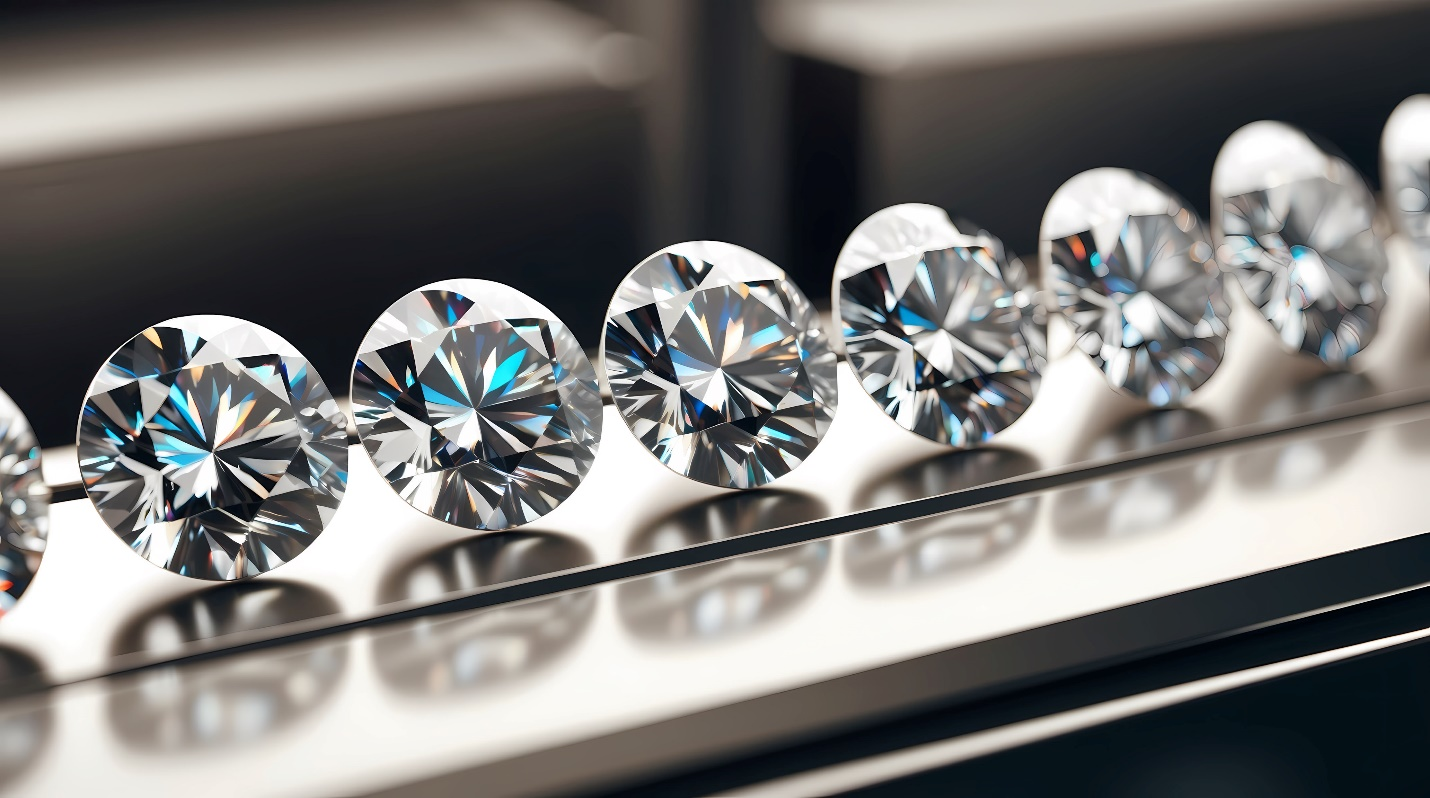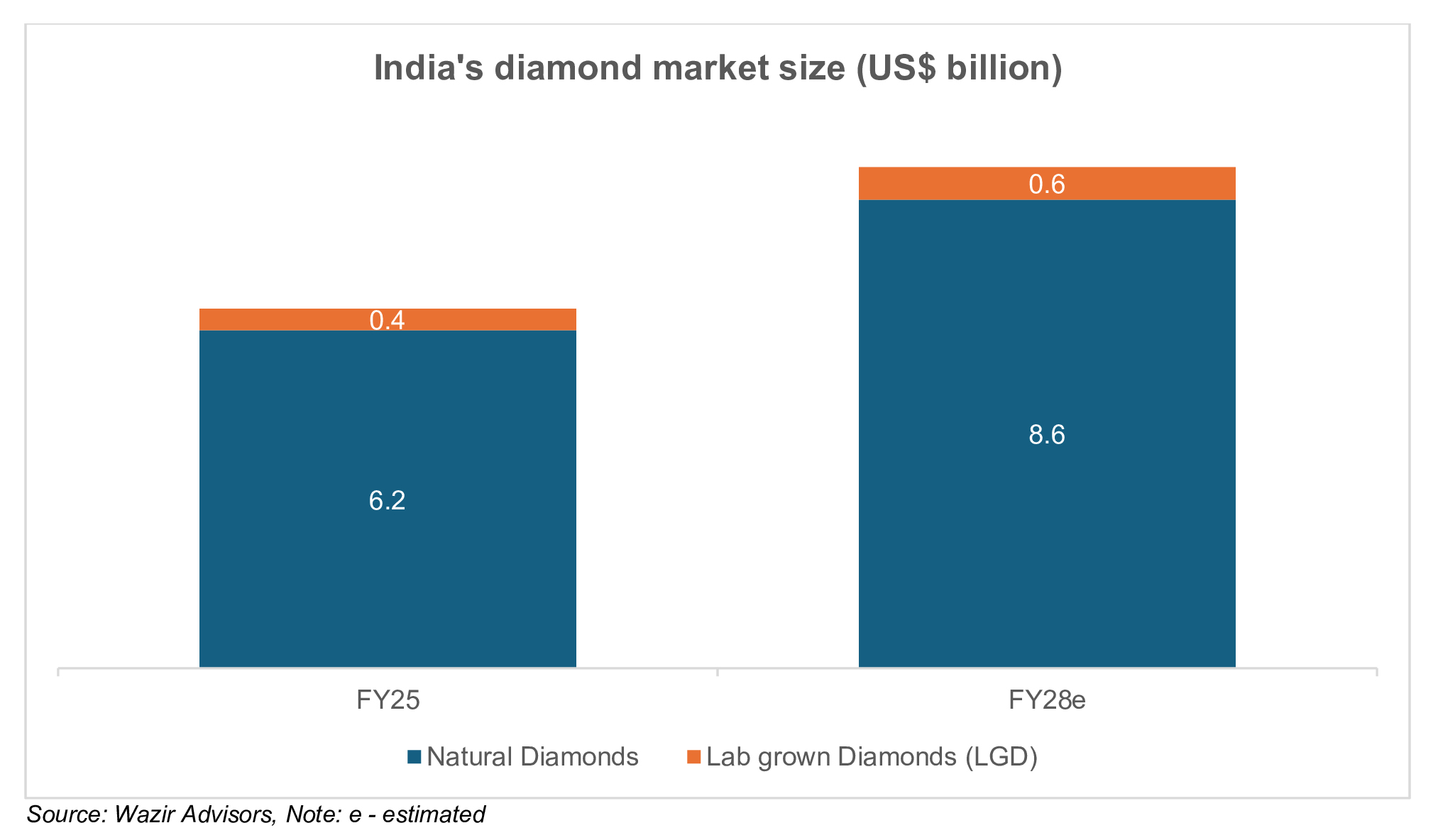SEARCH
RECENT POSTS
Categories
- Agriculture (28)
- Automobiles (18)
- Banking and Financial services (31)
- Consumer Markets (46)
- Defence (6)
- Ecommerce (19)
- Economy (66)
- Education (12)
- Engineering (6)
- Exports (21)
- Healthcare (24)
- India Inc. (8)
- Infrastructure (29)
- Manufacturing (26)
- Media and Entertainment (13)
- Micro, Small & Medium Enterprises (MSMEs) (15)
- Miscellaneous (30)
- Perspectives from India (33)
- Pharmaceuticals (4)
- Railways (4)
- Real Estate (16)
- Renewable Energy (17)
- Research and Development (8)
- Retail (1)
- Services (6)
- Startups (15)
- Technology (53)
- Textiles (6)
- Tourism (11)
- Trade (5)
India’s Sparkling Future: The Rise of Lab-Grown Diamonds

- Oct 24, 2025, 17:25
- Manufacturing
- IBEF
A diamond is forever and has been for generations the symbol of love, legacy and luxury. Its beauty, unchanging and pure, has made it timeless. But in a world that is constantly evolving, even the most enduring symbols are being reimagined.
Laboratories are changing the very nature of luxury globally, especially in India. Indistinguishable from natural diamonds, these are not knock-offs; they are lab-grown diamonds. What once lay beneath the earth’s surface for millions of years can now be created in a laboratory above it. They dazzle the same way and last forever but without the ethical burdens of a natural diamond. And in this story, India is emerging as both an innovator and a global leader.
What exactly are lab-grown diamonds?
The biggest myth that has followed the lab grown diamonds is that they are fake, yet the fact is that they are chemically, physically and optically the same as natural diamonds. They are also formed through state of art technologies like the chemical vapour deposition (CVD) and high-pressure high temperature (HPHT). Simply put they are diamonds, which have been built out of a carbon seed in a laboratory under the exact conditions that one would otherwise have on the earth.
Gemmologists, even those who are well experienced, cannot identify them without the help of sophisticated equipment, which can tell them apart from natural diamonds. The natural diamonds contain small traces of nitrogen, whereas the lab-grown diamonds are nitrogen-free, which is one of the determining factors professionals refer to during their identification. This is where India enters into the picture.
India is not just the world’s polishing hub, but an emerging diamond innovator
As of 2024 around 90% of the world’s diamonds are processed in India, accounting for approximately 75% of global turnover by value, according to Industrial Extension Bureau (iNDEXTb). But India is now doing more than just polishing, it is also producing.
According to Wazir Advisors, India’s diamond market is estimated at Rs. 53,512 crore (US$ 6.2 billion) in FY25 and is projected to grow to Rs. 74,227 crore (US$ 8.2 billion) by FY28, with a compound annual growth rate (CAGR) of 12%. While lab-grown diamonds represent a smaller, yet significant portion, the market’s value is estimated to be at about Rs. 3,452 crore (US$ 400 million) in FY25 and is poised to grow to Rs. 5,179 crore (US$ 600 million) by FY28, with a CAGR of 14%, according to Wazir Advisors.
In 2023, India produced over three million lab-grown diamonds, accounting for over 15% of the world’s total output, as per iNDEXTb.

Government backing
Recognising the potential of lab-grown diamonds, the Government of India has introduced several supportive measures:
- Seed grant: In the Union Budget of FY24, the Government provided a five-year Rs. 242 crore (US$ 28 million) seed grant to help set up a centre of laboratory-grown diamonds at the Indian Institute of Technology (IIT), Madras.
- Duty relief on seeds: Union Minister of Finance and Corporate Affairs Ms. Nirmala Sitharaman announced during the Union Budget of FY26 that the custom duty on the import of carbon seeds would no longer attract any custom duty, therefore being duty free in the financial year. The aim of this measure is to lower cost of local production and to become more competitive.
- 100% Foreign Direct Investments (FDI): The gems and jewellery sector, which entails laboratory-grown diamonds, has been opened to allow 100 % Foreign Direct Investments (FDI) to promote international investments.
Additionally, regulatory frameworks are being made clearer, and certifications specifically catered to lab grown diamonds are being created to increase consumer confidence. This push will help India become not just a polishing hub, but also a global manufacturing base for green luxury.
Moral and ecological advantages
One of the strongest selling points of lab-grown diamonds is their lighter environmental impact. Compared to traditionally mined natural diamonds, lab-grown diamonds:
- Use up to 90% less water
- Emits fewer greenhouse gases
- Requires no environmental disruptions or heavy machinery
- Is essentially conflict free and has nothing to do with human rights abuse or conflict funding that has marred select segments of the natural diamond mining and processing industry in the world context.
These advantages help brands market these diamonds to young and environmentally conscious people and establishes the notion of “luxury without the guilt.”
As per an article by Finshots, a single mined carat can displace up to 250 tonnes of earth and release close to 160 kilograms (KGs) of greenhouse gases into the atmosphere. As climate change awareness deepens, demand for laboratory-grown gems is only going to increase further.
A cultural shift
Throughout the Indian subcontinent, gold enjoys a status of superiority in the native customs be it weddings, religious rituals, festivals or the desire to gain financial security It is a blessed property, which is passed through the generations, and is viewed as an insuring system during times of uncertainty.
Bringing an incremental change in consumer preferences, increasing disposable incomes and changing behaviour, urban and value conscious consumers are welcoming the lab-grown diamonds. Lab-grown diamonds especially appeal to Millennial and Gen Z buyers. Companies such as Limelight Diamonds have even expanded into tier-two and tier-three cities to cater to different demographics. The choices of consumers are affected by factors such as:
- Affordability – Larger carats within the same budget.
- Sustainable- Significantly less harmful to the environment are more eco-friendly.
- Accessibility- Online e-commerce platforms such as CaratLane make browsing and buying products convenient.
- Demand – India now is the world’s second-largest consumer of diamond jewellery, thanks to rising middle class income and aspirations.
According to Bain & Co., 70 % of Indian consumers would not think of engagement ring without diamonds, and 75-80% of them are willing to pay more on diamond jewellery after the COVID-19 pandemic.
This change in perspective presents a radical shift in how luxury is perceived among younger generations. While gold is still associated with stability and tradition, diamonds are now being seen as modern, ethical and aspirational. Thus, buyers have started to demand jewellery with more symbolism and meaning rather than mere visual dazzle.
A bright future ahead
The Indian market shows great potential for growth, with exports projected to grow at a 15% CAGR through to 2034, as per Businessworld. Domestic demand is also set to maintain double-digit growth throughout the next decade. With continued policy support, growing demand and skilled workforce, India will surely lead the global lab-grown diamond market in no time.
This rapid growth is not just about numbers, it is about a change in mindset. More and more consumers want their purchases to reflect their values and aspirations, and these diamonds fulfil exactly that. As India continues to blend craftmanship with innovation, affordability with aspirations, the future of lab-grown diamonds may not just change India but also influence the entire world.
FAQs
What is the difference between lab-grown and natural diamonds in terms of impact?
Lab-grown diamonds are eco-friendly and conflict-free. Unlike mined diamonds, which displace up to 250 tonnes of earth and emit greenhouse gases, lab-grown diamonds use less water and energy.
How are lab-grown diamonds made?
Lab-grown diamonds are made using chemical vapour deposition (CVD) or high-pressure high temperature (HPHT) processes that replicate earth-like conditions. Under these controlled lab environments, carbon crystallizes into a diamond.
What is the market size of lab-grown diamonds in India?
India’s lab-grown diamond market is valued at Rs. 3,452 crore (US$ 400 million) and is projected to grow to Rs. 5,179 crore (US$ 600 million) by 2028, according to Wazir Advisors.
Are lab-grown diamonds real diamonds?
Yes, lab-grown diamonds are real diamonds with the same sparkle, hardness and structure as natural diamonds. The only difference is how they are made.
Lab-grown diamond vs. real diamond?
A lab-grown diamond is a real diamond made in a lab from a carbon seed using advanced technology. It is chemically and visually identical to a natural diamond, the only difference lies in its origin.
















